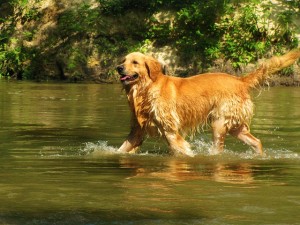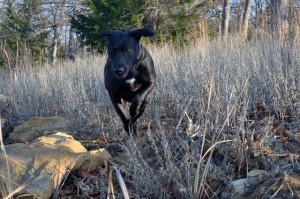
Today is World Rabies Day, an opportunity to raise awareness of the disease and how we can tackle it. We asked the Kennel Club, the society behind the journal Canine Genetics and Epidemiology, to tell us more about rabies and what is being done to protect dogs and dog owners. Guest blogger Aimee Llewellyn, Kennel Club Health Information Manager, gives us the details.
The chances of a dog or human catching rabies are almost non-existent in many countries, including the UK and US, but it is important for owners of man’s best friend to be aware of the risks to ensure that they, and their pets, stay happy and healthy.
Everyone has heard of rabies, but most of us don’t really know exactly what it is or how it could potentially affect them as dog owners. So what is it?
Rabies is a viral inflammatory disease that affects the grey matter of a dog’s brain, as well as its central nervous system, and in the vast majority of cases is lethal. In most documented cases the virus has been passed on by an infected animal biting a non-affected animal, and as rabies is a zoonotic disease it can be passed from one species to another, including from dog to human. The saliva of an infected animal can also spread the virus by coming into contact with open wounds or mucous membranes, such as the mouth and lips, nostrils, eyelids and ears.
In many parts of the world, rabies is still a common disease, with the World Health Organisation stating that over 55,000 people die each year from it. Whilst cases of rabies in the UK are almost non-existent, elsewhere, such as in eastern European Union (EU) Member States, including Romania and Poland, there are significant numbers reported in wildlife and some dogs. This raises issues surrounding pet travel from EU Member States into the UK, and vice versa, and is why the Kennel Club monitors any changes to the Department of Environment, Food and Rural Affairs (Defra)’s Pet Travel Scheme, which is in place to prevent these types of diseases coming into the country.

With the relaxation of the Pet Travel Scheme, the legitimate imports of dogs for commercial purposes has declined, and puppy traffickers have increased, using loopholes and poor enforcement under the Pet Travel Scheme to evade controls.
Puppies for sale are being disguised as pet dogs to avoid the commercial checks which are more stringent. According to reports from member states and enforcement officials, puppy traffickers have also forged vaccination certificates and microchips that are registered to both a fake owner and address.
The situation has exposed the UK to a higher risk of rabies and other diseases entering its borders, meaning it is all the more important for dog owners to be aware of the potential risks.
The EU and Defra have attempted to improve legislation to address the concerns outlined above by introducing a new Regulation (576/2013) that will come into effect on 29 December 2014. The new Regulation will introduce a number of changes to the EU pet travel rules and are designed to strengthen enforcement regimes across the EU and increase levels of compliance.
The Kennel Club believes that these changes will improve enforcement and increase compliance whilst helping to prevent illegal activity. However, concerns remain as to what extent these changes will be effective in tackling the current problems of illegal imports, as effective checks will only work if individuals declare themselves as transporting animals.
Within this framework of conducting checks, there will be a significant limitation on the effectiveness of enforcement carried out by carriers regardless of how strict the pet travel rules may be, which the Kennel Club will be closely monitoring.
As more and more people choose to take their dogs abroad with them when they go on holiday, it is important that owners are aware of what not to do if they are in a country where rabies is still a very real threat. To minimise any risk, owners should follow two simple rules – never approach a dog suspected of having rabies, and never to touch a dead animal that may have the disease.

Dog owners should keep their dogs away from dogs suspected of having rabies and never let them go near a dead animal. It is also recommend that those travelling to an area where rabies is common consider a rabies vaccination before travel. The NHS offers advice on rabies vaccinations. Dogs entering the UK or coming back from an EU or non-EU listed country must, in accordance with the Pet Travel Scheme, be vaccinated for rabies and owners should speak to their vet for advice.
Defra offers guidance on how to spot and report rabies in animals, which is a great resource for dog owners who may be concerned or wish to find out more about the signs of the disease. This includes spotting early clinical signs of rabies, identifying signs as the disease progresses and what the risk is to humans. As rabies is a notifiable disease, anyone who suspects it must, by law, report it to their nearest Animal Health and Veterinary Laboratories Agency office immediately.
Furthermore, it is crucial that anyone bringing a dog, or indeed any animal, into the UK from abroad is aware of the risks and follows the legal requirements for pet travel. This will help to eliminate any risk of unknowingly bringing rabies into the UK and will help to protect its millions of dogs and their owners.
You can find research and related content about World Rabies Day from both BioMed Central and Springer at https://www.springer.com/rabies.
- Microbial forensics: It’s not just fingerprints that can be left behind - 12th May 2015
- How can ‘conservation genomics’ help the recovery of the most endangered species? - 12th December 2014
- Acetate helps hypoxic cancer cells get fat - 11th December 2014
Comments